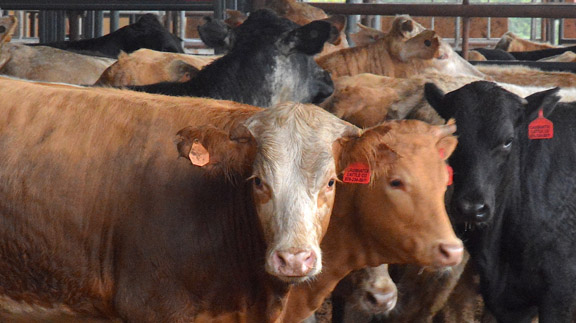Farm & Ranch
[AgriLife Today] Cattle market pressured by heavier weights, fewer heifer placements

Dr. David Anderson, Texas A&M AgriLife Extension Service livestock economist in College Station, said the recent cattle on feed report released by the U.S. Department of Agriculture depicts fewer heifers placed on feed, signaling continued expansion among producers across the country. (Texas A&M AgriLife Extension Service photo by Blair Fannin)
By: Blair Fannin
Writer: Blair Fannin, 979-845-2259, [email protected]
Contact: Dr. David Anderson, 979-845-4351, [email protected]
COLLEGE STATION – More feedlot placements than expected, coupled with large supplies of cold storage beef, will pressure cattle prices in the near term, according to a Texas A&M AgriLife Extension Service livestock economist.
Dr. David Anderson, livestock economist in College Station, said the recent cattle on feed report released by the U.S. Department of Agriculture depicts fewer heifers placed on feed, signaling continued expansion among producers across the country.
“The report has indicated the running themes we have had throughout 2015, which has been fewer placements and a trend in placing heavier animals,” he said. “This is being driven by fewer cows and calves in 2014 and continued in 2015. There were heavy financial losses by cattle feeder operators in 2015. They paid premiums for those animals and then the market dropped lower, forcing them to hold onto to those feeders and add more gain to compensate for the premium they paid.”
The USDA report indicated placements were slightly lower, about one percent less than the year before, Anderson said.
“More cattle were placed weighing over 700 and 800 pounds while total placements declined,” Anderson said. “The report indicated fewer placed, but heavier. The result of the cattle on feed report was half a percent lower than the year before. I think as the market digests this there will be bearish talk in terms of the futures market because placements are bigger than expected and marketings are lower than expected.”
Anderson said the report also included a quarterly breakdown of heifers on feed.
“This report historically goes back to 1996,” he said. “We found in the latest report this was the fewest number of heifers on feed Jan. 1 than in the past 20 years. This gives you more evidence of the strength of expansion going on. We’ve got more steers on feed than a year ago and a record low number of heifers on feed.”
Anderson pointed to another report, the beef cold storage report, that indicated a record supply of beef on hand.
“Throughout 2015, we built up a record supply of cold storage of beef,” he said. “In December, we put more beef in cold storage, more than we did in November. This points out there is a heck of a lot of beef in cold storage. In this case, it’s due to record imports of beef that we brought in, because of record high prices, strength of the dollar and drought in Australia. When it comes here it has to stay somewhere cold, so it stays in the cold chain.
“Going forward, most cold-storage beef is boneless beef that is made into ground beef. That’s a large supply we’ve got to work off going through 2016. As beef imports back off during the year, it will help bring those storage amounts down.”
To view Anderson’s video comments, see http://bit.ly/1RJbGny .
-30-
LikeTweet
Find more stories, photos, videos and audio at http://today.agrilife.org
Farm & Ranch
Ag Elsewhere: Wyoming

By Tressa Lawrence
Babies are tucked away in every nook and cranny. Many ranchers across Wyoming have baby animals popping up all over this time of year.
Farm & Ranch
Ag Elsewhere: Montana

By Lindsey Monk
Another load of grain in to keep feeding the calves until the green grass can really start popping.
Farm & Ranch
Meanwhile, Back at the Ranch….

By Rayford Pullen | [email protected]
Spring has sprung and hopefully the rains will continue where our country will heal from the previous droughts and our grasses will thrive. We are especially hopeful for the Panhandle of Texas where our neighbors and friends have been dealt a deadly blow to homes, ranges, livestock, and people. Keep them in your prayers as they will not be able to return to normal for many years if at all. Having lost their ability to benefit from this great cattle market is a double whammy for all of them.
Now is the time of year when we need to take care of business as it relates to our new calves that have been hitting the ground this spring. First and foremost is vaccinating for Blackleg followed by deworming with a white wormer and the IBR complex. Blackleg is a soil-born disease and with pastures extremely short this spring our calves have been grazing the green grass as soon as it shows itself, making them even more vulnerable to picking contaminates from the soil.
To read more, pick up a copy of the April issue of NTFR magazine. To subscribe by mail, call 940-872-5922.
-

 Country Lifestyles1 year ago
Country Lifestyles1 year agoScott & Stacey Schumacher: A Growth Mindset
-

 Equine7 months ago
Equine7 months agoThe Will to Win
-

 Country Lifestyles7 years ago
Country Lifestyles7 years agoStyle Your Profile – What your style cowboy hat says about you and new trends in 2017
-

 Country Lifestyles4 years ago
Country Lifestyles4 years agoAmber Crawford, Breakaway Roper
-

 HOME7 years ago
HOME7 years agoGrazing North Texas – Wilman Lovegrass
-

 Country Lifestyles7 years ago
Country Lifestyles7 years agoDecember 2016 Profile, Rusty Riddle – The Riddle Way
-

 Country Lifestyles8 years ago
Country Lifestyles8 years agoJune 2016 Profile – The man behind the mic: Bob Tallman
-

 Country Lifestyles8 years ago
Country Lifestyles8 years agoCowboy Culture with Clay Reid – Being a Man






